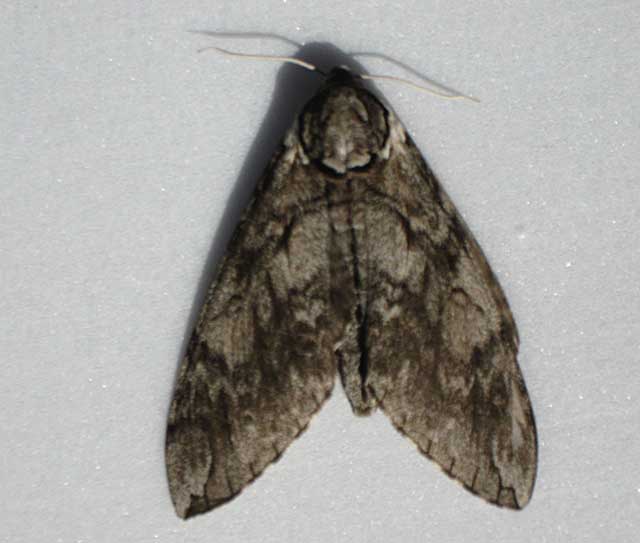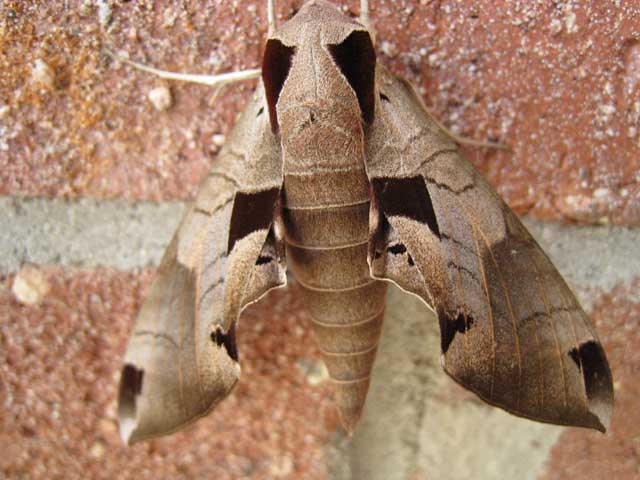Sphinginae subfamily
Sphingini tribe:
 |
Ceratomia amyntor WO,
the Elm Sphinx or Four-horned Sphinx
The upperside of the forewing is brown with dark brown and white markings including a white costal area near the wing base, dark streaks along the veins, and
a white spot in the cell. edge of range
|
 |
The upperside of the forewing is pale brownish gray with wavy black
and white lines and a black-outlined white cell spot.
It is named for the wavy lines on the forewings. |
Ceratomia undulosa, Denver, July, 2010, courtesy of Julie Groves.
 |
This large bodied moth flies in tobacco fields and vegetable gardens (potatoes, tomatoes)
and wherever host plants are found. edge of range
|
 |
If you grow tomatoes, you may have encountered it, but it has not been
officially reported in Denver.
Larvae get very large and can strip a tomato plant. edge of range
|
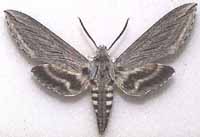 |
The upperside of the forewing is pale silver-gray with a series of
black dashes, a white patch at the tip, and a white stripe along the
outer margin. The upperside of the hindwing is black with blurry
white bands. edge of range
|
 |
Sphinx chersis
USGS,
the Northern Ash Sphinx or Great Ash Sphinx
Larval hosts are ash,
lilac, privet, cherry, and quaking aspen.
|
 |
Forewings, long and slender, are held close to the body when the moth
is at rest. The costal and terminal areas of the forewing are much
lighter than slate grey colouration of the rest of the wing.
|
 |
Sphinx luscitiosa
WO,
the Canadian Sphinx or
Clemen's Sphinx
Forewing upperside is yellowish gray in males and pale
gray with a faint yellow tint in females (female to left). Dark
border on outer margin widens as it approaches inner margin.
Hw upperside is deep yellow in males,
pale yellow in females, both with wide dark border.
|
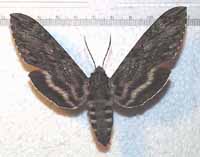 | The upperside of the forewing is dark gray with black and light gray
wavy lines. The upperside of the hindwing is black with a brownish
gray border and two white bands.
|
 |
Sphinx vashti USGS, the Snowberry Sphinx:
Snowberry Sphinx adults fly as a single brood in montane woodlands and along prairie
streamcourses from April to August.
The upperside of the forewing has a narrow black subterminal line
bordered by a white inverted V-shaped line on the outside, and a
black line at the apex.
|
Smerinthini Tribe:
 |
Pachysphinx modesta
WO,
the Modest Sphinx or Poplar Sphinx,
This moth has a large, heavy body, and females
can be remarkably plump. Lines are blurred, less distinct than in
P. occidentalis.
|
 |
This one is quite similar to Pachysphinx modesta, with modesta
being smaller and darker.
Moths should be on the wing from June-August.
|
 |
Paonias excaecata
USGS, the Blinded Sphinx:
The outer margin of the forewing is quite wavy. There
is a dark cell spot and a dark oblique line mid wing from the
costa almost to the inner margin. Basic ground colour is
pinkish brown. Flight would be June-July.
|
 | Named for the small eye-spot in the
hindwing, this moth has a wide
distribution.
|
 |
Smerinthus cerisyi
WO, the Cerisyi's
Sphinx or One-eyed Sphinx, Larvae feed on poplars and willows.
Flight would be from late May-July-early August as a single brood.
|
 |
Smerinthus jamaicensis
USGS,
the Twin-spotted Sphinx
This moth is widely distributed and fairly common.
Along the East Coast, it flies from P.E.I. to Florida.
It is less common in the southwest.
|
Macroglossinae subfamily
Dilophonotini tribe:
 |
This species is not reported in Arapahoe County,
and would likely only be there as a rare migrant stray
from further south.
Males and females differ.
|
 |
Hemaris diffinis
USGS,
Snowberry Clearwing; Bumblebee Moth:
Very variable species, but almost always the
abdomen sports contrasting black and yellow hairs, the ventral
surface being quite black. The legs also tend to be quite dark and
there is a black mask running across the eye and along the sides of
the thorax.
|
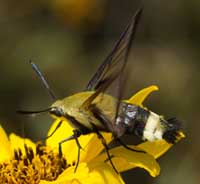 |
Hemaris thetis,
WO, Thetis Clearwing Moth
These moths, possibly just a form of diffinis, have brownish-olive or olive-green heads and thoraxes.
The abdomen, which has a broad yellow band, is black or olive-green
above and yellow below. Their wings have a very narrow brown border
and the clear parts of the wings have a steel-blue luster. generally in western Colorado
|
Philampelini tribe:
 |
Eumorpha achemon
USGS/RT,
the Achemon Sphinx.
Adults nectar from flowers of Japanese honeysuckle
(Lonicera japonica), petunia (Petunia hybrida),
mock orange (Philadelphus coronarius), and phlox (Phlox).
Fight would be from June to August. Larvae feed on grape foliage.
|
Eumorpha achemon, Denver, July 29, 2011, Rhonda Tucker.
Macroglossini tribe:
 |
Amphion floridensis
USGS,
the Nessus Sphinix
This day flier is widely distributed. If you have Virginia Creeper,
you probably have the Nessus Sphinx.
Two bright, distinct, narrow yellow
bands are often visible on the abdomen.
|
 |
Hyles lineata
USGS/JBG/LC,
White-lined Sphinx:
Forewing upperside: dark olive brown with paler brown along
costa and outer margin, narrow tan band running from wing tip
to base, and white streaks along veins.
Hindwing upperside: black with reddish pink median band.
|
Hyles lineata, Denver, June 20, 2012, John B. Gilmore
Hyles lineata, Denver, June 11, 2014, Laura Culver
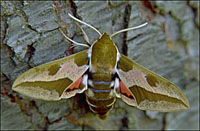 |
Hyles euphorbiae
WO, the Spurge Hawk Moth
The body is light brown with various white and dark brown
markings, while the wings have a conspicuous tan, brown, and pink or
red color pattern. Range is spreading.
|
 |
Hyles gallii
WO, the Bedstraw Hawk Moth
Gallium Sphinx:
Reported in northern CO. Some years I see them on P.E.I., some years, I do not.
|
 |
Darapsa myron
WO, Virginia Creeper Sphinx;
Grapevine Sphinx:
Forewing upperside: dark brown to pale yellowish gray, with
olive tint, sometimes quite green.
On costal margin there is dark rectangular patch, although this
may be reduced or absent. Hindwing upperside: pale
orange.
|
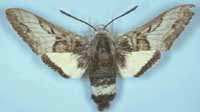 |
Euproserpinus wiesti
WO, Prairie Sphinx; Wiest's Primrose Sphinx:
Black body with white band on abdomen. FW upperside
gray-brown; median area has black lines; gray band;
underside white with black o. m..
Hw upperside yellowish white with narrow black
o. m., black at base.
|
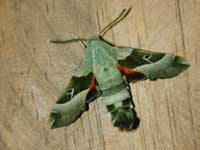 |
The upperside of the forewing is pale gray-green with a deep
green-brown median area and a white dash at the wing tip.
|
|
|
